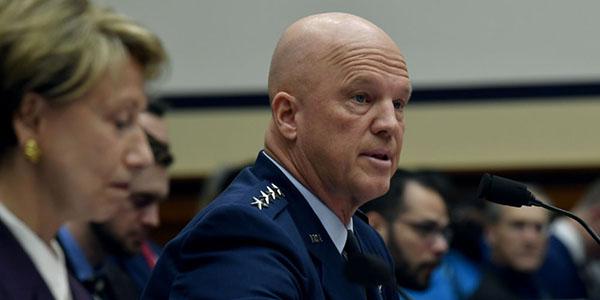Space Force To Rely More on the Commercial Satellite Industry
The four-month-old U.S. Space Force is setting its priorities for the future, and part of that is a plan to leverage key partnerships with allies, the intelligence community and the commercial space industry. And while partnerships with the commercial space industry in regard to launch services have been quite visible, the Space Force is set to work more frequently with the producers of small communications satellite systems, said Gen. John “Jay” Raymond, USAF, chief of operations, U.S. Space Force.
Gen. Raymond, speaking together with Chief Master Sgt. Roger Towberman, USAF, senior enlisted advisor, U.S. Space Force, during an April 16 virtual town hall, emphasized that the service would leverage proliferated low-earth-orbit (LEO) constellations built by the commercial industry.
“Historically, what has been commercially viable in space are commercial launches and large communications satellites … and our space architecture, if you will, was really large satellites in very small numbers,” Gen. Raymond observed. “As the barriers to entry into space are reduced and more people can get into space–we even have students building satellites at different universities around the country for launch into orbit--and the small satellites become more operationally viable, there are multiple segments that are now going to be commercially viable and we want to leverage those.”
More and more commercial producers are pursuing constellations of thousands of LEO satellites, and leveraging the industry’s investment will change the military’s business model in space, the general said. “I think what you are going to see is a kind of hybrid approach going forward,” he noted.
The Space Force is well aware of the growing threat from adversaries in space, including from Russia’s direct-ascent anti-satellite (DA-ASAT) missile they are developing to destroy LEO satellites, which the country reportedly tested on April 15.
“Russia’s DA-ASAT test provides yet another example that the threats to U.S. and allied space systems are real, serious and growing,” said Gen. Raymond in a statement about the test. “The United States is ready and committed to deterring aggression and defending the Nation, our allies and U.S. interests from hostile acts in space.”
In February, Russia conducted tests of their COSMOS 2542 and COSMOS 2543 in-orbit satellites, which “exhibited characteristics of a space weapon, conducted maneuvers near a U.S. government satellite,” which in any other domain would be viewed as “irresponsible and potentially threatening,” the statement said.
“This test is further proof of Russia’s hypocritical advocacy of outer space arms control proposals designed to restrict the capabilities of the United States while clearly having no intention of halting their counterspace weapons programs,” Gen. Raymond stressed. “Space is critical to all nations and our way of life. The demands on space systems continue in this time of crisis where global logistics, transportation and communication are key to defeating the COVID-19 pandemic. It is a shared interest and responsibility of all spacefaring nations to create safe, stable and operationally sustainable conditions for space activities, including commercial, civil and national security activities.”
Given the hostile environment, the Space Force will continue the Air Force’s legacy of working with allies to develop and operate key satellite systems. “We are working really hard to develop partnerships with our closest allies around the globe,” Gen. Raymond stated. That work will provide opportunities for Space Force personnel, he added. “We see great opportunities in foreign officer areas or just being a liaison officer assigned to a partner nation ops [operations] center,” the general said. “We are working that today. We think this is a big growth industry for the space business, and we think there are plenty of opportunities to get stationed with our allied partner.”
“We are also working very closely with the intelligence community, he said.
You may also be interested in:
Adding the Force to the Space Force
DARPA Doubles Down on Blackjack
Air Force SMC 2.0 Effort Is Driving Innovation into Space





Comments